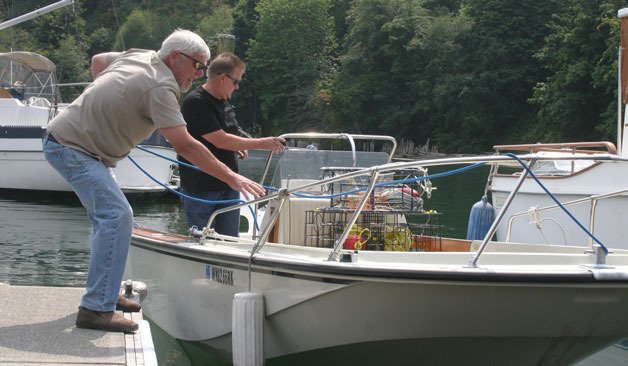Things are hard to predict on the water. From the wind to finance, sea voyage can be tricky.
The same could be said of moorage rates for South Whidbey Harbor, commonly called Langley marina.
Commissioners of the Port of South Whidbey said they do not know what the occupancy of its new dock space will be upon completion of a new breakwater.
“We basically haven’t raised rates since we took over,” said Ed Field, the port manager. “We purposefully put off raising rates until we had something to show for it.”
Only six annual moorage spots are available in Langley, which has 34 slips. They cost $7.50 per foot, per month. Turnover in the annual moorage is low, while port staff and commissioners said demand is high with a waiting list of about 100.
The port district expects to bring in $230,000 in revenue from the new harbor with a 10 percent across-the-board increase in rates and fees.
For transient moorage, rates would increase to $1.17 per foot, per night. Commissioners are playing a guessing game with how many boats, and perhaps more importantly, what kinds and sizes of ships will visit South Whidbey Harbor once the new breakwater is installed.
With expansion of the dock by 380 linear feet, allowing 60-foot yachts to tie up for a few nights may be more lucrative for the port district and the South End than mooring a couple of 30-foot boats in that same space for a year.
“It’s kind of a dart-board thing,” said Commissioner Dennis Gregoire.
Under the current commissioners’ direction, the port pursued economic development opportunities and projects.
The commissioners said the intent was to allow for more boaters to pull into Langley and dine and shop in town. They may also visit Clinton and Freeland, stay a couple of nights before sailing away.
“I’ve been monitoring people coming over this summer – June, July, August – and they don’t have thin wallets,” Gregoire said.
With an expanded capacity on the horizon with the new breakwater and dock, the commissioners said they want to limit their variables. Rather than rely on a “If you build it, they will come” mentality, the board wants to see what kind of traffic the new harbor brings in before hiking the rates to capitalize on the improvements.
One thing appears certain with the new harbor, however. With an increased capacity, the port will likely need a part-time assistant harbormaster in Langley to aid the full-time harbormaster.
“Since we took over, we went from zero staffing to you pull up and we meet you there and grab your lines,” Field said.
“And we haven’t raised rates.”
Port commissioners said they wanted to increase the number of annual moorage spaces from the current six, and also find a way to increase rates in a way that generates a general revenue increase of 10 percent.
Commissioners Chris Jerome, Curt Gordon and Gregoire agreed the port district won’t have an accurate picture of how to best change moorage rates for at least one or two years after the breakwater is in place
The plan is to make South Whidbey Harbor a self-sufficient operation, meaning the money it takes to operate the marina in Langley would be covered by the revenue it brings in from moorage rates and utility fees.
Rotating “transient” boats into the spaces on a regular basis is one way port officials said they envision putting South Whidbey Harbor in the black.
“Our goal for the first year is to fill it up,” Field said.
Assistant Harbormaster David Schaal was busy July 31 helping boats dock in Langley. The day and night before crabbing is legal are busy times for he and Harbormaster Duncan McPhee.
Schaal said several local boats moor at South Whidbey Harbor from Wednesday to Friday to crab. Come the weekend, the small harbor can be several boats deep on the outside ends of its slips.
Maximizing the spaces is one of the major tasks ahead of the port. Field and the harbormaster will need to look at what kind of boats to offer long-term and seasonal mooring, such as commercial vessels and tourism boats.
One recent money generating venture was the Mystic Sea, a whale-watching ship that docked in Langley this spring. Gordon wondered whether its success was genuine or built upon the ship’s novelty and pent up anticipation by whale watchers in the area.
Either way, port officials said they will work out a way to accommodate ships like the Mystic Sea, crabbing boats and 24-foot one-night sailboats.



